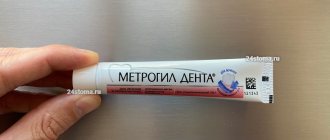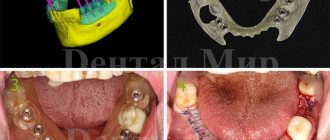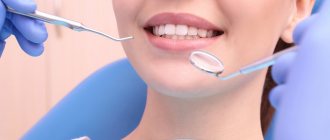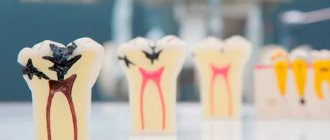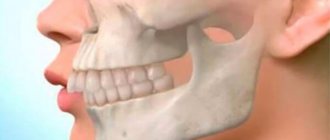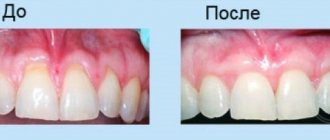Oral hygiene
The main cause of most oral diseases is the active proliferation of pathogenic microorganisms. We can conclude that the main preventive measure in dentistry is regular and high-quality oral hygiene. Let's look at the important rules:
|
Features and types of prevention
The trend towards an increase in the number of detected pathologies of the dental system, which has emerged in recent years, determines the importance of timely implementation of preventive measures. Prevention of dental diseases is a separate scientific discipline, within which methods are developed to protect the oral cavity from negative factors.
The system of preventive measures is differentiated into three broad sections.
Primary prevention
The list of basic measures to prevent the occurrence of diseases includes:
- Professional hygienic cleaning of the oral cavity and dentition;
- Teaching patients how to brush their teeth at home;
- Formation of a nutrition program taking into account the characteristics of the body;
- Prescribing a complex of restorative drugs that strengthen teeth and gums.
Dental prevention in children also involves holding a conversation with a young patient about the need to competently and efficiently care for the teeth and oral cavity, which allows for the formation of stable motivation to follow basic recommendations.
Secondary prevention
The main focus at this stage is the localization of identified diseases and the provision of measures to prevent further spread or recurrence of pathology that can lead to chronic stages. The dentist must carry out sanitation of the oral cavity, with the help of which inflammatory symptoms are relieved.
Tertiary prevention
The presence of late-stage diseases in a patient raises the question of preserving the functionality of the jaw row. As a rule, surgical methods and orthopedic technologies are used to restore integrity.
Eating habits
The condition of our teeth largely depends on what we eat. It is recommended to minimize the intake of fast carbohydrates (various sweets, flour, carbonated sweet water, etc.). It is necessary to saturate the diet with fermented milk products, fresh fruits and vegetables. It is important that the body does not experience a deficiency of vitamins or microelements.
Important! Food that is too cold or hot is extremely harmful to teeth; this can lead to increased sensitivity of the enamel.
Preventive dental procedures
At your dentist’s appointment, you can perform several preventive procedures that will protect your teeth from various diseases:
|
Recommendations from experts
The most important preventative measure is regular visits to the dentist.
. Experts strongly recommend dental examinations at least twice a year. This will allow timely detection of possible pathological processes, such as caries and other dental diseases. In the early stages, they can be easily stopped without the likelihood of relapse and complications.
Important! You should immediately visit a dentist if you experience enamel sensitivity, bleeding gums, toothache or discomfort while eating. These symptoms may indicate developing pathological processes.
Compliance with the above measures guarantees the preservation of oral health for many years.
Prevention of dental diseases.
Currently, the majority of patients seeking dental care suffer from various forms of periodontal disease.
Modern epidemiological data indicate not only the significant prevalence of periodontal pathology in children and adults, but also the influence on the incidence of dental plaque, oral hygiene, poor-quality dentures and fillings, dentoalveolar deformities, occlusal trauma, disruption of the structure of the tissues of the vestibule of the oral cavity, and characteristics of the oral cavity. breathing; medications used, previous and concomitant diseases, extreme factors leading to disruption of the compensatory mechanisms of natural immunity, etc.
The increase in pathology of organs and tissues of the oral cavity cannot be stopped by therapeutic measures. In this regard, it is necessary to develop and widely implement into practice measures to prevent major dental diseases.
To date, the relationship between the condition of the periodontium and the level of individual oral hygiene has been proven. Soft dental plaque, accumulating in the area of the necks of the teeth and in the interdental spaces, contributes to the launch of the mechanism of destruction of the entire periodontal complex, starting with inflammation of the gums and destruction of the periodontal attachment and ending with a severe destructive process in the bone tissue of the alveolar processes of the jaws.
Despite the availability of a wide variety of hygiene products on the modern market, the state of oral hygiene among the vast majority of the population remains unsatisfactory.
From the above, the need for the prevention of dental diseases should be considered generally recognized, therefore, all patients who initially applied to the dental clinic must be motivated to perform thorough oral hygiene using preventive agents, be sure to demonstrate the quality of oral care using coloring solutions, tell about the leading the role of microbial factors in the occurrence and development of inflammatory periodontal diseases.
Of the approximately 15–20 teeth that a person loses between the ages of 40–65 years, in most cases the cause of this loss is periodontitis. Huge amounts of money are spent on restoring chewing function in cases of partial or complete edentia. Worldwide, orthopedic treatment of patients with periodontal disease is the most expensive dental service. Maintaining dental health determines not only the normal functioning of the dental system and the entire human body, but also the quality of his life.
The main etiological factor should be recognized as the microflora of the oral cavity. In other words, lack of oral hygiene or its poor quality as the main risk factor will undoubtedly lead to gingivitis and caries. According to WHO (2002), about 95% of the adult population of the planet and 80% of the child population have certain signs of periodontopathies.
To prevent periodontal diseases in the early stages, the most effective is professional oral hygiene, including training in the rules of oral hygiene, monitoring their implementation, and constant motivation of the patient during both the first and subsequent courses of treatment. Therefore, special attention should be paid to the introduction, teaching and control of oral hygiene in early childhood and during the child’s growing up stages. Only optimization and intensification of oral hygiene will solve the problems of caries as a carious disease and gingivitis as a starting point for periodontitis, since dental plaque and dental plaque negatively affect both the hard tissues of the tooth and the periodontium.
Prevention is a system of government, social, hygienic and medical measures aimed at ensuring a high level of health and preventing diseases of the oral cavity and the body as a whole. The main goal of prevention is to eliminate the causes and conditions for the occurrence and development of diseases, as well as to increase the body’s resistance to the effects of adverse environmental factors.
According to the WHO classification, prevention is usually divided into primary, secondary and tertiary.
Primary prevention is the use of methods and means to prevent the occurrence of dental diseases.
If initial signs of damage appear, then as a result of preventive measures they may stabilize or undergo reverse development.
Primary prevention methods include:
– individual oral hygiene;
– professional oral hygiene;
– endogenous use of fluoride preparations;
– use of local prophylactic means;
– dental education of the population.
Personal hygiene involves careful and regular removal of dental plaque from the surfaces of the teeth and gums by the patient himself using various hygiene products (toothbrushes, toothpastes and gels, chewing gum, elixirs, rinses, interdental oral hygiene products).
The best way to prevent the development of periodontal disease is to completely remove plaque from teeth through professional oral hygiene.
The presence of a pathological process in periodontal tissues is determined by the condition of the gums. The criteria for healthy gums are pink color, pointed tips of the interdental papillae, tissue density, and absence of bleeding. Inflammatory phenomena in the gums are characterized by the following signs: hyperemia, cyanosis, swelling,
The goal of professional oral hygiene is the prevention and treatment of diseases of the hard tissues of the teeth and oral mucosa. The term “professional oral hygiene” refers to the thorough removal of soft and hard dental plaque from all surfaces of the teeth and subsequent treatment of teeth and gums with prophylactic agents.
Professional oral hygiene includes several sequential activities:
- Conducting a conversation with the patient about the need for professional oral hygiene, about the dangers of dental plaque and dental deposits for the hard tissues of the tooth and gums, and forming in the patient a correct understanding of the importance of this issue.
- Teaching the patient the rules of personal oral hygiene. Conducted over several visits
- Preparation of the oral cavity consists of irrigating with a weak antiseptic solution.
- Removal of dental plaque. Removing dental plaque includes removing plaque, tartar, grinding and polishing teeth. It is advisable to remove tartar not immediately, but over several visits, especially if they occupy large areas on various surfaces of the teeth.
- Coating the surface of teeth with fluoride-containing or remineralizing preparations.
Secondary prevention is the use of traditional treatment methods to stop the developing pathological process and tissue preservation.
These methods include the treatment of dental caries (filling, endodontic procedures), therapeutic and surgical treatment of periodontal diseases, and treatment of other oral diseases.
Tertiary prevention is the restoration of lost function using means that replace missing tissue, and rehabilitation of patients, bringing their condition as close to normal as possible.
Hygienic education of the population needs optimization and intensification. Today, oral hygiene should be taught not only to children, but also to their parents. Only comprehensive dental educational work will activate auditory and visual motivation, improve hygienic skills and theoretical knowledge about dental health.
Optimization and intensification of oral hygiene consists of the targeted use of motivational methods of hygienic education, professional oral hygiene, and the use of clinically and cost-effective modern medications. It is necessary to create a theoretical foundation, strive to develop cognitive activity among the population, arouse interest and desire to receive information, as well as instill manual skills, maintain and improve hygienic knowledge and skills.
“To prevent the “smile of the 21st century” from becoming completely toothless and transforming into “edentulism of the 21st century”, we need to study oral hygiene, learn it ourselves and teach it to our patients, so that there is no such moment that there is nothing left to treat and there is no one to treat” ( Ulitovsky S.B., 2000).
Dentist-orthopedist of the highest category
Head of the Orthopedic Department
Tour Svetlana Nikolaevna

